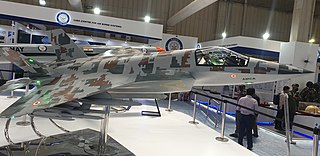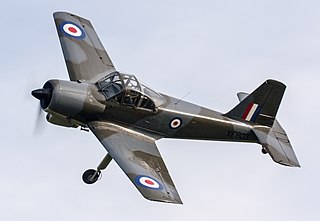
Avionics are the electronic systems used on aircraft. Avionic systems include communications, navigation, the display and management of multiple systems, and the hundreds of systems that are fitted to aircraft to perform individual functions. These can be as simple as a searchlight for a police helicopter or as complicated as the tactical system for an airborne early warning platform.

Fly-by-wire (FBW) is a system that replaces the conventional manual flight controls of an aircraft with an electronic interface. The movements of flight controls are converted to electronic signals transmitted by wires, and flight control computers determine how to move the actuators at each control surface to provide the ordered response. Implementations either use mechanical flight control backup systems or else are fully electronic.

The General Dynamics F-16 Fighting Falcon is an American single-engine supersonic multirole fighter aircraft originally developed by General Dynamics for the United States Air Force (USAF). Designed as an air superiority day fighter, it evolved into a successful all-weather multirole aircraft with over 4,600 built since 1976. Although no longer purchased by the U.S. Air Force, improved versions are being built for export. In 1993, General Dynamics sold its aircraft manufacturing business to the Lockheed Corporation, which became part of Lockheed Martin after a 1995 merger with Martin Marietta.

A joystick, sometimes called a flight stick, is an input device consisting of a stick that pivots on a base and reports its angle or direction to the device it is controlling. A joystick, also known as the control column, is the principal control device in the cockpit of many civilian and military aircraft, either as a centre stick. It has various switches to control the movements of the aircraft controlled by the Pilot and First Officer of the flight.

A fixed-wing aircraft is a heavier-than-air flying machine, such as an airplane, which is capable of flight using aerodynamic lift. Fixed-wing aircraft are distinct from rotary-wing aircraft, and ornithopters. The wings of a fixed-wing aircraft are not necessarily rigid; kites, hang gliders, variable-sweep wing aircraft and airplanes that use wing morphing are all classified as fixed-wing aircraft.

An aircraft pilot or aviator is a person who controls the flight of an aircraft by operating its directional flight controls. Some other aircrew members, such as navigators or flight engineers, are also considered aviators because they are involved in operating the aircraft's navigation and engine systems. Other aircrew members, such as drone operators, flight attendants, mechanics and ground crew, are not classified as aviators.

A cockpit or flight deck is the area, on the front part of an aircraft or spacecraft, from which a pilot controls the aircraft.

A stick shaker is a mechanical device designed to rapidly and noisily vibrate the control yoke of an aircraft, warning the flight crew that an imminent aerodynamic stall has been detected. It is typically present on the majority of large civil jet aircraft, as well as most large military planes.

A conventional fixed-wing aircraft flight control system (AFCS) consists of flight control surfaces, the respective cockpit controls, connecting linkages, and the necessary operating mechanisms to control an aircraft's direction in flight. Aircraft engine controls are also considered flight controls as they change speed.

A trainer is a class of aircraft designed specifically to facilitate flight training of pilots and aircrews. The use of a dedicated trainer aircraft with additional safety features—such as tandem flight controls, forgiving flight characteristics and a simplified cockpit arrangement—allows pilots-in-training to safely advance their skills in a more forgiving aircraft.

HOTAS, an acronym of hands on throttle-and-stick, is the concept of placing buttons and switches on the throttle lever and flight control stick in an aircraft cockpit. By adopting such an arrangement, pilots are capable of performing all vital functions as well as flying the aircraft without having to remove their hands from the controls.

A stabilator is a fully movable aircraft horizontal stabilizer. It serves the usual functions of longitudinal stability, control and stick force requirements otherwise performed by the separate parts of a conventional horizontal stabilizer and elevator. Apart from reduced drag, particularly at high Mach numbers, it is a useful device for changing the aircraft balance within wide limits, and for reducing stick forces.

In aeronautics, air brakes or speed brakes are a type of flight control surface used on an aircraft to increase the drag on the aircraft. When extended into the airstream, air brakes cause an increase in the drag on the aircraft. When not in use, they conform to the local streamlined profile of the aircraft in order to help minimize drag.

A yoke, alternatively known as a control wheel or a control column, is a device used for piloting some fixed-wing aircraft.

The Advanced Medium Combat Aircraft (AMCA) is an Indian single-seat, twin-engine, all-weather fifth-generation stealth, multirole combat aircraft being developed for the Indian Air Force and the Indian Navy. The Mark-1 variant of the aircraft will be a fifth generation fighter while the Mark-2 variant will have sixth-generation technologies. The aircraft is designed by the Aeronautical Development Agency (ADA) - an aircraft design agency under MoD. A Special Purpose Vehicle (SPV) consisting of ADA, Hindustan Aeronautics Limited (HAL) and a private company is being formed for the development and production of AMCA. In March 2024, the project received approval from India's Cabinet Committee on Security for the prototype development.

The Portuguese Air Force is the aerial warfare force of Portugal. Locally it is referred to by the acronym FAP but internationally is often referred to by the acronym PRTAF. It is the youngest of the three branches of the Portuguese Armed Forces.
A stick pusher is a device installed in some fixed-wing aircraft to prevent the aircraft from entering an aerodynamic stall. Some large fixed-wing aircraft display poor post-stall handling characteristics or are vulnerable to deep stall. To prevent such an aircraft approaching the stall the aircraft designer may install a hydraulic or electro-mechanical device that pushes forward on the elevator control system whenever the aircraft's angle of attack reaches the pre-determined value, and then ceases to push when the angle of attack falls sufficiently. A system for this purpose is known as a stick pusher.

The Percival P.56 Provost is a basic trainer aircraft that was designed and manufactured by British aviation company Percival.

A side-stick or sidestick controller is an aircraft control stick that is located on the side console of the pilot, usually on the righthand side, or outboard on a two-seat flightdeck. Typically this is found in aircraft that are equipped with fly-by-wire control systems.

The SIPA S.200 Minijet was a light sporting jet aircraft designed and produced by the French aircraft manufacturer Société Industrielle Pour l’Aéronautique (SIPA). It is designed to perform liaison, training, and aerobatic flights. The Minijet was claimed to be the first jet-powered light touring aircraft




















